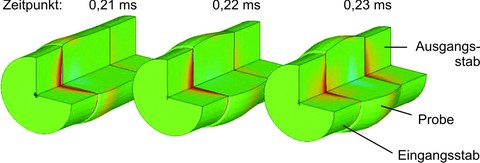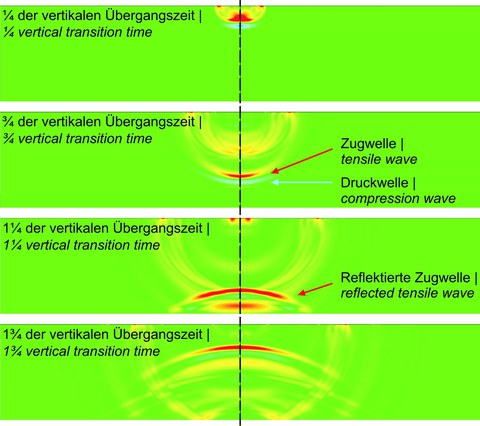Modeling of the concrete behaviour under fast loading
Table of contents
Project data
| Titel | Title TP Modellierung im Verbundvorhaben: Verhalten von Beton bei hohen Belastungsgeschwindigkeiten | SP Modeling in the joint project Material behaviour of concrete under high loading velocity Förderer | Funding Bundesministerium für Wirtschaft und Technologie (BMWi) Zeitraum | Period 07/2009 – 12/2012 Leiter | Project manager Prof. Dr.-Ing. habil. Ulrich Häußler-Combe Bearbeiter | Contributor Tino Kühn M.Sc. |
Report in the yearbook 2012
Simulation of Concrete Under High Strain Rates

Simulation of an experiment in a Split-Hopkinson bar Visualization
Concrete behaves differently under dynamic loading than at static load. This has been observed in numerous experiments. But what are the physical causes of this phenomenon? How does the behaviour of concrete structures change, when the loading rate is further increased? What happens than inside of a component? Is it possible to transfer effects that have been observed in small laboratory samples to larger components?
To investigate these and similar questions numerically, we work in this research project on a constitutive model to describe the material behaviour of concrete at the macro level. The numerical simulation is intended to reflect what happens inside a concrete structure due to dynamic loading and how the stresses change spatially and temporally.
The picture on the left page shows the results of a concrete sample loaded within an uniaxial Split-Hopkinson bar under high distortion rates. It is easy to see how the shock wave spreads from the input bar through the cylindrical concrete specimen to the output bar. The figure also shows that the stresses near the centre axis of the sample is higher (red areas) than at the outer edge (green areas).
Increasing loading rates result in increasing strain rates in the concrete. Here, lower and higher strain rates can be distinguished. One assumes different physical causes for the strain rate increase in both of these regions. For smaller strain rates up to about 1 1/s viscous effects in the concrete matrix or rearrangements of moisture in the pores result in an increased load bearing capacity. At higher strain rates of about 100 1/s inertial effects come to the foreground. That means that the crack opening occurs delayed and thus effects the seemingly higher sustainability. Even higher strain rates, where constitutional changes of the material play a role, are not considered in this research project.
The numerical simulation with the newly developed VERD model (Visco-Elastic Retarded Damage Retarded) takes into account the static assumptions as well as both above described physical effects. A comparison of the calculated damage (right picture) shows that in a dynamic analysis with the VERD model a raised concrete carrying capacity can be represented numerically. In the classical, static analysis the increase in concrete strength under dynamic load was not taken into account and thus a greater damage is evident in the concrete beam.
Report in the yearbook 2011
A Viscous Retarded Damage Model for Extensive Strain Rates

Computationally pressure wave distribution determined at different times after short-wave impact load
The behaviour of concrete seams not always as statically and linear elastic accurately as one may assume from the everyday work with it. With extensive rates of loading, how they arise for example within the civilian range with car or airplane impacts or in addition within the military range e.g. with the protection of solid defensive structures against penetration, concrete behaves docile and reacts with a much higher strength which can reach almost the eightfold at tensile loads and the threefold within the compressive domain compared to the static values. This effect can be used to with the dimensioning of such buildings. But however, more important is the correct description of such material behaviour for the computer assisted modelling and design of structure for extraordinary load cases, for which in the presented project a novel material formulation has been developed.
That material model is based on two physically motivated assumptions to the strain rate dependent damage behaviour of the concrete. Based on a classical static damage model this was modified with a viscoelastic approach for the low strain rate domain and extended for higher rates with a retarded damage model. The latter virtual describes the structural inertia on the crack wall of micro cracks which are relevant at higher crack opening velocities. In contrast the viscous part of the model considers for example delay effects which are introduced by the porosity of the mortar and however the presence of some enclosed media.
The complex dynamic behaviour of a simple standard structure attacked by an impulse load is illustrated in the figures. Contrary to classical static behaviour the dynamic is essentially determined by propagation, reflections and interferences of pressure waves in the specimen. According to the load impulse, for example with low strain rates, compressive damages at the impact zone and the supports, or however later tensile damages, which lead to the crack start at the bottom surface, take place. With higher strain rates however the impulse leads to local flaking at the top side of the bar, which is represented in the second picture. The developed material model is able to cover all these phenomena.
